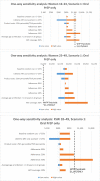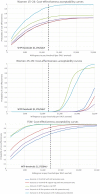The cost-effectiveness of multi-purpose HIV and pregnancy prevention technologies in South Africa
- PMID: 29537654
- PMCID: PMC5851344
- DOI: 10.1002/jia2.25064
The cost-effectiveness of multi-purpose HIV and pregnancy prevention technologies in South Africa
Abstract
Introduction: A number of antiretroviral HIV prevention products are efficacious in preventing HIV infection. However, the sexual and reproductive health needs of many women extend beyond HIV prevention, and research is ongoing to develop multi-purpose prevention technologies (MPTs) that offer dual HIV and pregnancy protection. We do not yet know if these products will be an efficient use of constrained health resources. In this paper, we estimate the cost-effectiveness of combinations of candidate multi-purpose prevention technologies (MPTs), in South Africa among general population women and female sex workers (FSWs).
Methods: We combined a cost model with a static model of product impact based on incidence data in South Africa to estimate the cost-effectiveness of five candidate co-formulated or co-provided MPTs: oral PrEP, intravaginal ring, injectable ARV, microbicide gel and SILCS diaphragm used in concert with gel. We accounted for the preferences of end-users by predicting uptake using a discrete choice experiment (DCE). Product availability and protection were systematically varied in five potential rollout scenarios. The impact model estimated the number of infections averted through decreased incidence due to product use over one year. The comparator for each scenario was current levels of male condom use, while a health system perspective was used to estimate discounted lifetime treatment costs averted per HIV infection. Product benefit was estimated in disability-adjusted life years (DALYs) averted. Benefits from contraception were incorporated through adjusting the uptake of these products based on the DCE and through estimating the costs averted from avoiding unwanted pregnancies. We explore the additional impact of STI protection through increased uptake in a sensitivity analysis.
Results: At central incidence rates, all single- and multi-purpose scenarios modelled were cost-effective among FSWs and women aged 16-24, at a governmental willingness-to-pay threshold of $1175/DALY averted (range: $214-$810/DALY averted among non-dominant scenarios), however, none were cost-effective among women aged 25-49 (minimum $1706/DALY averted). The cost-effectiveness of products improved with additional protection from pregnancy. Estimates were sensitive to variation in incidence assumptions, but robust to other parameters.
Conclusions: To the best of our knowledge, this is the first study to estimate the cost-effectiveness of a range of potential MPTs; suggesting that MPTs will be cost-effective among higher incidence FSWs or young women, but not among lower incidence older women. More work is needed to make attractive MPTs available to potential users who could use them effectively.
Keywords: HIV prevention; South Africa; discrete choice experiments; key populations; multi-purpose prevention; pre-exposure prophylaxis.
© 2018 The Authors. Journal of the International AIDS Society published by John Wiley & sons Ltd on behalf of the International AIDS Society.
Figures







Similar articles
-
Cost-Effectiveness of HIV Pre-exposure Prophylaxis Among Heterosexual Men in South Africa: A Cost-Utility Modeling Analysis.J Acquir Immune Defic Syndr. 2020 Jun 1;84(2):173-181. doi: 10.1097/QAI.0000000000002327. J Acquir Immune Defic Syndr. 2020. PMID: 32141959
-
Evaluating the potential impact and cost-effectiveness of dapivirine vaginal ring pre-exposure prophylaxis for HIV prevention.PLoS One. 2019 Jun 26;14(6):e0218710. doi: 10.1371/journal.pone.0218710. eCollection 2019. PLoS One. 2019. PMID: 31242240 Free PMC article.
-
Epidemiological impact and cost-effectiveness of providing long-acting pre-exposure prophylaxis to injectable contraceptive users for HIV prevention in South Africa: a modelling study.J Int AIDS Soc. 2019 Dec;22(12):e25427. doi: 10.1002/jia2.25427. J Int AIDS Soc. 2019. PMID: 31855323 Free PMC article.
-
Multipurpose prevention technologies: products in development.Antiviral Res. 2013 Dec;100 Suppl:S39-47. doi: 10.1016/j.antiviral.2013.09.030. Epub 2013 Nov 1. Antiviral Res. 2013. PMID: 24188708 Review.
-
Lessons from reproductive health to inform multipurpose prevention technologies: don't reinvent the wheel.Antiviral Res. 2013 Dec;100 Suppl:S25-31. doi: 10.1016/j.antiviral.2013.09.019. Epub 2013 Nov 1. Antiviral Res. 2013. PMID: 24188700 Review.
Cited by
-
HIV prevention is not all about HIV - using a discrete choice experiment among women to model how the uptake and effectiveness of HIV prevention products may also rely on pregnancy and STI protection.BMC Infect Dis. 2020 Sep 25;20(1):704. doi: 10.1186/s12879-020-05399-4. BMC Infect Dis. 2020. PMID: 32977745 Free PMC article.
-
Preferences for Long-Acting PrEP Products Among Women and Girls: A Quantitative Survey and Discrete Choice Experiment in Eswatini, Kenya, and South Africa.AIDS Behav. 2024 Mar;28(3):936-950. doi: 10.1007/s10461-023-04202-0. Epub 2023 Nov 16. AIDS Behav. 2024. PMID: 37971614 Free PMC article.
-
Prevention method preferences and factors influencing hypothetical choice among women in South Africa: a survey exploring opportunities for a multipurpose prevention technology implant.Front Reprod Health. 2024 Jun 25;6:1368889. doi: 10.3389/frph.2024.1368889. eCollection 2024. Front Reprod Health. 2024. PMID: 38983594 Free PMC article.
-
Towards a roadmap to advance non-hormonal contraceptive multipurpose prevention technologies: strategic insights from key stakeholders†.Biol Reprod. 2020 Aug 4;103(2):289-298. doi: 10.1093/biolre/ioaa092. Biol Reprod. 2020. PMID: 32639007 Free PMC article. Review.
-
Acceptability and feasibility of leveraging community-based HIV counselling and testing platforms for same-day oral PrEP initiation among adolescent girls and young women in Eastern Cape, South Africa.J Int AIDS Soc. 2022 Jul;25(7):e25968. doi: 10.1002/jia2.25968. J Int AIDS Soc. 2022. PMID: 35872602 Free PMC article.
References
-
- Molina J‐M, Capitant C, Spire B, Pialoux G, Cotte L, Charreau I, et al. On‐demand preexposure prophylaxis in men at high risk for HIV‐1 infection. N Engl J Med. 2015;373(23):2237–46. - PubMed
-
- Nel A, Kapiga S, Bekker L‐G, Devlin B, Borremans M, Rosenberg Z, et al. Safety and Efficacy of Dapivirine Vaginal Ring for HIV‐1 Prevention in African Women. CROI 2016; Seattle, USA 2016.
-
- Baeten JM, Palanee‐Phillips T, Brown ER, Schwartz K, Soto‐Torres LE, Nel A, et al. A Phase III Trial of the Dapivirine Vaginal Ring for HIV‐1 Prevention in Women. Conference on Retroviruses and Opportunistic Infections Boston, MA 2016.
Publication types
MeSH terms
LinkOut - more resources
Full Text Sources
Other Literature Sources
Medical
Miscellaneous

